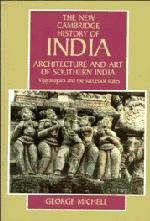5 - Palace architecture
Published online by Cambridge University Press: 28 March 2008
Summary
Compared with the abundance of temples surviving from the Vijayanagara and Nayaka periods, there is a marked scarcity of royal architecture. This reflects the perishable materials out of which courtly buildings tended to be constructed, as well as the repeated sieges, raids and destructive attacks to which they were subjected over the years. During the centuries under review, most royal monuments experienced a cycle of occupation, devastation and abandonment. This situation continued even into modern times, with the British themselves dismantling the residences of local rulers, as at Srirangapattana. The result is that the only courtly complexes preserved to any extent in Southern India today were either deserted before the Europeans arrived, or were sufficiently distant from cities and towns not to be adversely affected by urban development in subsequent centuries.
Palaces assigned to this era lack any precise historical context. Even when a royal monument is popularly associated with a particular monarch, such as the palace of Tirumala Nayaka at Madurai, there is usually a dearth of supporting documents. This does not negate the very real connection between monarchs and their residences; it merely obscures the actual chronology. Further confusion is caused by the fact that most military and courtly complexes were extended over considerable periods of time, resulting in long and complicated building histories.
- Type
- Chapter
- Information
- Architecture and Art of Southern IndiaVijayanagara and the Successor States 1350–1750, pp. 121 - 154Publisher: Cambridge University PressPrint publication year: 1995

